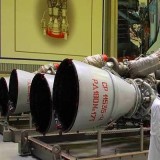Analysis: New B-21 Bomber to Become the Cornerstone of US Air Force Amid China’s Stealth Aircraft Expansion

{loadposition bannertop}
{loadposition sidebarpub}
The U.S. Air Force’s advancement of the B-21 Raider stealth bomber program comes at a critical juncture as China unveils its latest-generation stealth aircraft, signaling a significant shift in the balance of military power. With an initial order of 100 aircraft and potential for further expansion, the B-21 is set to replace the aging B-1 Lancer and B-2 Spirit bombers, reinforcing the U.S. Global Strike Command’s strategic capabilities.Follow Army Recognition on Google News at this link
A B-21 Raider undergoes comprehensive flight testing—including ground evaluations, taxiing, and airborne operations—at Edwards Air Force Base, California, as it advances toward becoming the cornerstone of the U.S. Air Force’s bomber fleet. (Picture source: U.S. DoD)
Developed by the American Company Northrop Grumman, the B-21 Raider stealth bomber will serve as the cornerstone of U.S. long-range strike operations, ensuring dominance in an era of renewed great-power competition. Its development is crucial as the Pentagon seeks to counter China’s rapid advancements in military aviation technology, which now pose an increasing threat to U.S. interests and regional stability.
The B-21 Raider represents a significant leap in U.S. strategic airpower, designed to penetrate the most advanced enemy air defense systems and conduct precision strikes with unparalleled survivability. As a sixth-generation stealth bomber, the B-21 incorporates state-of-the-art stealth technology, reducing its radar signature to near-undetectable levels, enabling it to evade sophisticated detection systems like China’s HQ-9 and Russian-made S-400. Equipped with advanced sensor fusion and artificial intelligence-driven mission systems, the B-21 can autonomously adapt to evolving threats in highly contested environments. Its dual-capable nature allows it to deliver both nuclear and conventional munitions, ensuring the U.S. maintains credible deterrence across multiple domains.
The B-21’s extended range and in-flight refueling capabilities make it a critical asset for power projection in the Indo-Pacific, allowing the U.S. to strike targets deep within Chinese territory without relying on forward-deployed bases that are increasingly vulnerable to China’s long-range precision missile systems. Its modular open-system architecture ensures continuous upgrades and integration of future technologies, providing a decisive edge over potential adversaries like China. As Beijing accelerates the development of its stealth platforms, the B-21 Raider will play a crucial role in maintaining U.S. air dominance, deterring aggression, and reassuring allies in an increasingly contested global security environment.
On December 26, 2024, a symbolic date marking Mao Zedong’s birthday, the Chinese Communist Party (CCP) unveiled a new fleet of stealth aircraft, reportedly designated the J-36, a next-generation stealth fighter, and the H-20, China’s first strategic stealth bomber. These developments signify a significant leap forward in China’s airpower capabilities, highlighting Beijing’s growing ambitions to challenge U.S. air superiority in the Indo-Pacific region and beyond. The J-36, believed to be a twin-engine fifth-generation fighter, is positioned to rival the U.S. F-35 Lightning II with enhanced stealth features, sensor fusion, and long-range strike capabilities. Meanwhile, the H-20 bomber is expected to challenge the dominance of U.S. strategic bombers by offering a long-range platform capable of penetrating deep into enemy airspace and delivering nuclear and conventional payloads against key strategic targets.
The unveiling of the J-36 and H-20 underscores the urgency for the United States to modernize its combat aircraft fleet. The B-21 Raider’s introduction is a pivotal response to this challenge, offering next-generation stealth technology designed to penetrate heavily defended environments dominated by China’s advanced air defense systems, such as the HQ-9 and Russian-made S-400 equivalents. The B-21’s stealth capabilities, combined with its ability to conduct both nuclear deterrence and conventional strike missions, provide the U.S. with a flexible and credible strategic deterrent. Its extended operational range allows it to project power deep into contested regions without reliance on forward basing, a critical advantage given China’s expanding military footprint in the South China Sea and beyond.
Despite the U.S. maintaining a technological edge in stealth aircraft development, China’s rapid military advancements are narrowing the gap. The J-36 is an evolution of the J-20 stealth fighter, reportedly incorporating improved avionics, artificial intelligence-assisted situational awareness, and electronic warfare capabilities. The H-20, modeled after the U.S. B-2 Spirit in terms of design philosophy, is expected to offer China its first true long-range strategic strike capability, with the ability to target U.S. military installations in the Indo-Pacific and beyond. These developments represent a growing challenge to U.S. air dominance, increasing the need for accelerated deployment of platforms such as the B-21 and the continued development of the Next Generation Air Dominance (NGAD) program, which aims to produce a sixth-generation fighter with unparalleled capabilities in air superiority and electronic warfare.
In addition to modernizing its bomber fleet, the U.S. must invest in complementary technologies such as unmanned combat aerial vehicles (UCAVs), hypersonic weapons, and electronic warfare systems to maintain its strategic edge. China’s focus on artificial intelligence-driven warfare and integrated air defense systems necessitates a holistic approach to defense modernization, ensuring U.S. forces remain capable of operating in highly contested environments. The B-21 Raider, with its open-architecture design and modularity, provides a foundation for continuous upgrades and adaptation to emerging threats, an advantage China’s relatively newer defense industry may struggle to match in terms of operational experience and sustainment.
As geopolitical tensions continue to rise, the introduction of the B-21 Raider is a clear demonstration of the U.S. commitment to maintaining air superiority and deterring potential adversaries. The unveiling of China’s J-36 and H-20 serves as a stark reminder of the shifting global military balance, highlighting the need for the United States to remain proactive in countering emerging threats in the Indo-Pacific theater. The B-21, alongside the upcoming NGAD fighter, represents a critical component of the U.S. strategy to deter aggression, reassure allies, and project power globally in the face of growing Chinese military capabilities.
The next decade will be decisive in shaping the future of airpower, with the B-21 Raider stealth bomber standing as a testament to America’s enduring commitment to defending its strategic interests and maintaining global stability. The race for air dominance is intensifying, and the U.S. must continue to leverage its technological expertise, industrial capacity, and strategic alliances to stay ahead of emerging threats and challenges in the evolving geopolitical landscape.

{loadposition bannertop}
{loadposition sidebarpub}
The U.S. Air Force’s advancement of the B-21 Raider stealth bomber program comes at a critical juncture as China unveils its latest-generation stealth aircraft, signaling a significant shift in the balance of military power. With an initial order of 100 aircraft and potential for further expansion, the B-21 is set to replace the aging B-1 Lancer and B-2 Spirit bombers, reinforcing the U.S. Global Strike Command’s strategic capabilities.
Follow Army Recognition on Google News at this link
A B-21 Raider undergoes comprehensive flight testing—including ground evaluations, taxiing, and airborne operations—at Edwards Air Force Base, California, as it advances toward becoming the cornerstone of the U.S. Air Force’s bomber fleet. (Picture source: U.S. DoD)
Developed by the American Company Northrop Grumman, the B-21 Raider stealth bomber will serve as the cornerstone of U.S. long-range strike operations, ensuring dominance in an era of renewed great-power competition. Its development is crucial as the Pentagon seeks to counter China’s rapid advancements in military aviation technology, which now pose an increasing threat to U.S. interests and regional stability.
The B-21 Raider represents a significant leap in U.S. strategic airpower, designed to penetrate the most advanced enemy air defense systems and conduct precision strikes with unparalleled survivability. As a sixth-generation stealth bomber, the B-21 incorporates state-of-the-art stealth technology, reducing its radar signature to near-undetectable levels, enabling it to evade sophisticated detection systems like China’s HQ-9 and Russian-made S-400. Equipped with advanced sensor fusion and artificial intelligence-driven mission systems, the B-21 can autonomously adapt to evolving threats in highly contested environments. Its dual-capable nature allows it to deliver both nuclear and conventional munitions, ensuring the U.S. maintains credible deterrence across multiple domains.
The B-21’s extended range and in-flight refueling capabilities make it a critical asset for power projection in the Indo-Pacific, allowing the U.S. to strike targets deep within Chinese territory without relying on forward-deployed bases that are increasingly vulnerable to China’s long-range precision missile systems. Its modular open-system architecture ensures continuous upgrades and integration of future technologies, providing a decisive edge over potential adversaries like China. As Beijing accelerates the development of its stealth platforms, the B-21 Raider will play a crucial role in maintaining U.S. air dominance, deterring aggression, and reassuring allies in an increasingly contested global security environment.
On December 26, 2024, a symbolic date marking Mao Zedong’s birthday, the Chinese Communist Party (CCP) unveiled a new fleet of stealth aircraft, reportedly designated the J-36, a next-generation stealth fighter, and the H-20, China’s first strategic stealth bomber. These developments signify a significant leap forward in China’s airpower capabilities, highlighting Beijing’s growing ambitions to challenge U.S. air superiority in the Indo-Pacific region and beyond. The J-36, believed to be a twin-engine fifth-generation fighter, is positioned to rival the U.S. F-35 Lightning II with enhanced stealth features, sensor fusion, and long-range strike capabilities. Meanwhile, the H-20 bomber is expected to challenge the dominance of U.S. strategic bombers by offering a long-range platform capable of penetrating deep into enemy airspace and delivering nuclear and conventional payloads against key strategic targets.
The unveiling of the J-36 and H-20 underscores the urgency for the United States to modernize its combat aircraft fleet. The B-21 Raider’s introduction is a pivotal response to this challenge, offering next-generation stealth technology designed to penetrate heavily defended environments dominated by China’s advanced air defense systems, such as the HQ-9 and Russian-made S-400 equivalents. The B-21’s stealth capabilities, combined with its ability to conduct both nuclear deterrence and conventional strike missions, provide the U.S. with a flexible and credible strategic deterrent. Its extended operational range allows it to project power deep into contested regions without reliance on forward basing, a critical advantage given China’s expanding military footprint in the South China Sea and beyond.
Despite the U.S. maintaining a technological edge in stealth aircraft development, China’s rapid military advancements are narrowing the gap. The J-36 is an evolution of the J-20 stealth fighter, reportedly incorporating improved avionics, artificial intelligence-assisted situational awareness, and electronic warfare capabilities. The H-20, modeled after the U.S. B-2 Spirit in terms of design philosophy, is expected to offer China its first true long-range strategic strike capability, with the ability to target U.S. military installations in the Indo-Pacific and beyond. These developments represent a growing challenge to U.S. air dominance, increasing the need for accelerated deployment of platforms such as the B-21 and the continued development of the Next Generation Air Dominance (NGAD) program, which aims to produce a sixth-generation fighter with unparalleled capabilities in air superiority and electronic warfare.
In addition to modernizing its bomber fleet, the U.S. must invest in complementary technologies such as unmanned combat aerial vehicles (UCAVs), hypersonic weapons, and electronic warfare systems to maintain its strategic edge. China’s focus on artificial intelligence-driven warfare and integrated air defense systems necessitates a holistic approach to defense modernization, ensuring U.S. forces remain capable of operating in highly contested environments. The B-21 Raider, with its open-architecture design and modularity, provides a foundation for continuous upgrades and adaptation to emerging threats, an advantage China’s relatively newer defense industry may struggle to match in terms of operational experience and sustainment.
As geopolitical tensions continue to rise, the introduction of the B-21 Raider is a clear demonstration of the U.S. commitment to maintaining air superiority and deterring potential adversaries. The unveiling of China’s J-36 and H-20 serves as a stark reminder of the shifting global military balance, highlighting the need for the United States to remain proactive in countering emerging threats in the Indo-Pacific theater. The B-21, alongside the upcoming NGAD fighter, represents a critical component of the U.S. strategy to deter aggression, reassure allies, and project power globally in the face of growing Chinese military capabilities.
The next decade will be decisive in shaping the future of airpower, with the B-21 Raider stealth bomber standing as a testament to America’s enduring commitment to defending its strategic interests and maintaining global stability. The race for air dominance is intensifying, and the U.S. must continue to leverage its technological expertise, industrial capacity, and strategic alliances to stay ahead of emerging threats and challenges in the evolving geopolitical landscape.






